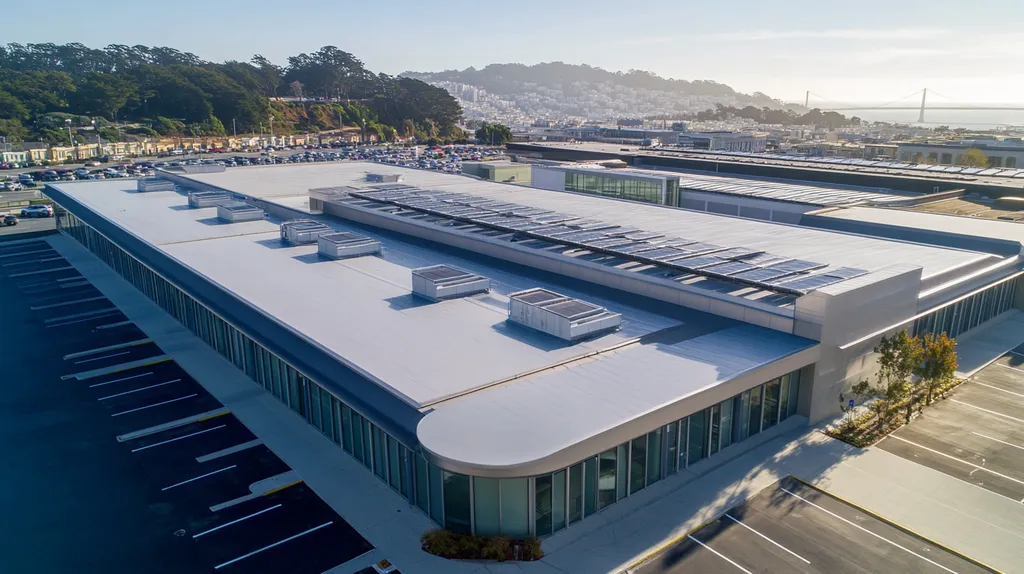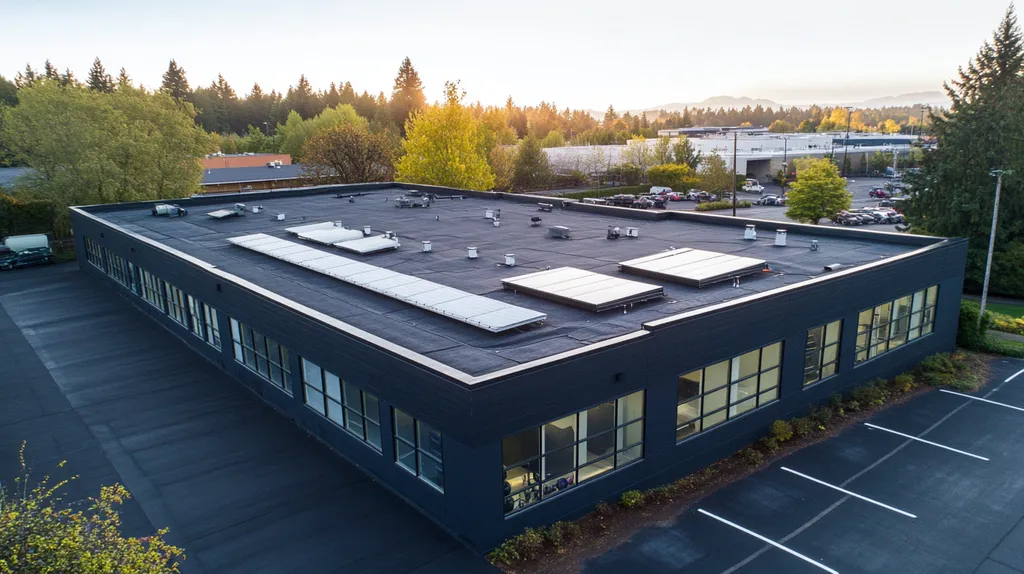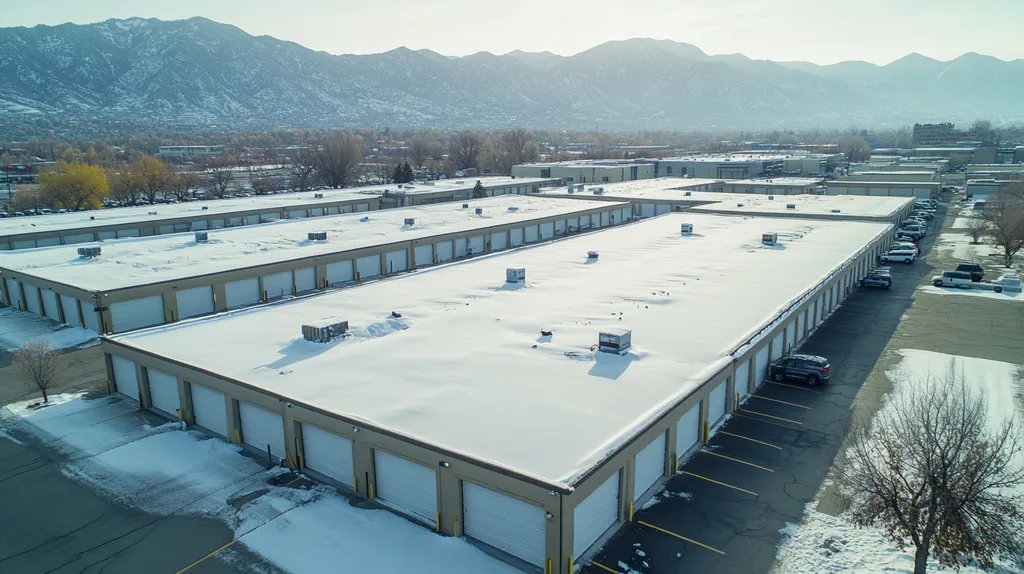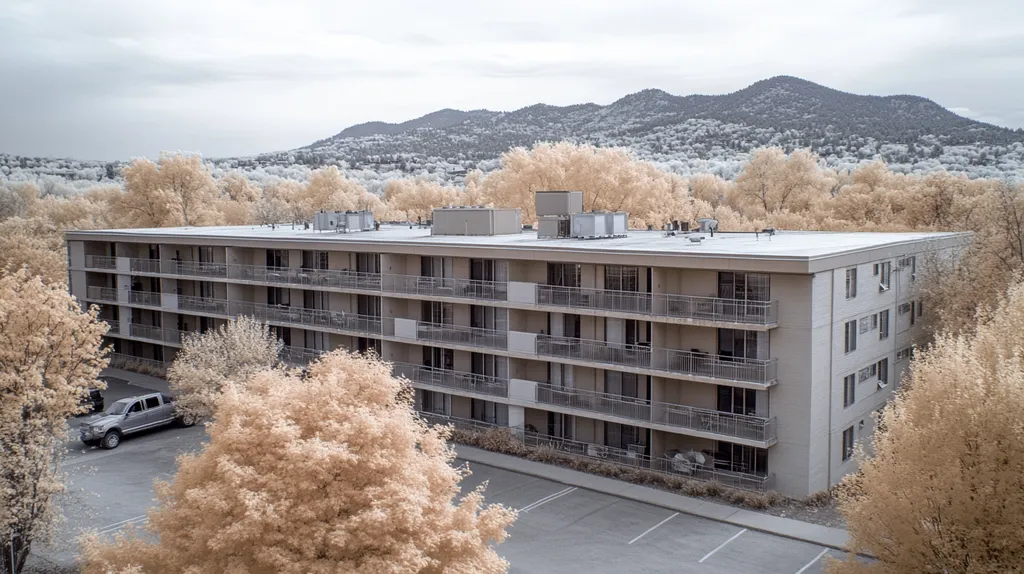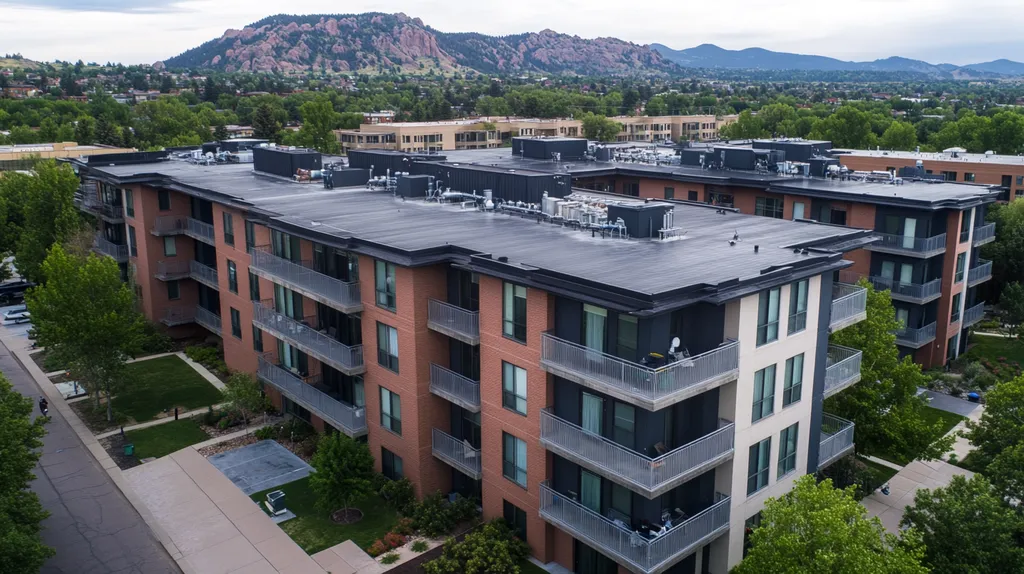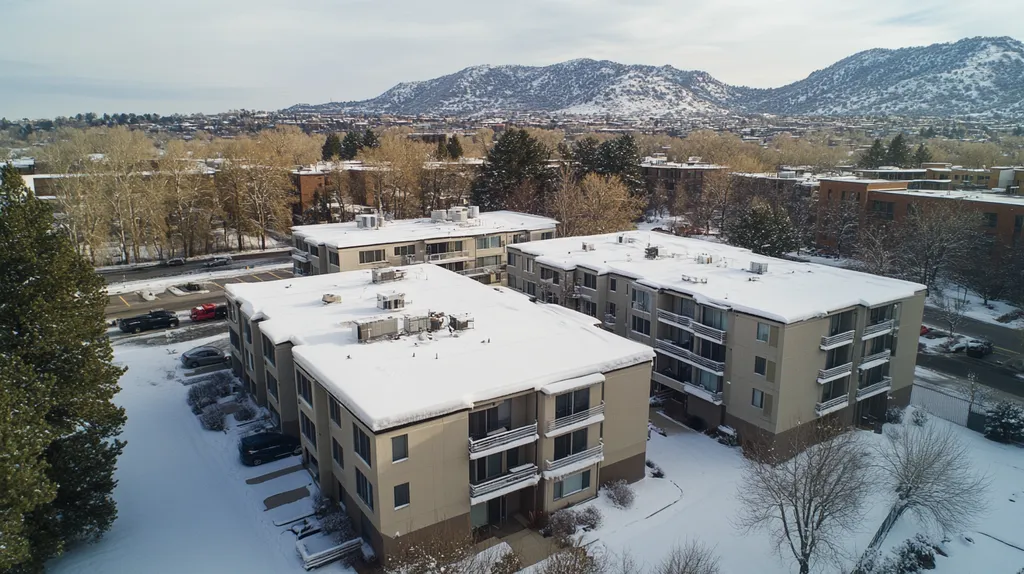Indoor air quality issues linked to commercial roofing decisions cost businesses over $150 billion annually in lost productivity and health-related expenses, according to recent EPA data. Yet many property owners continue to overlook this critical connection.
From volatile organic compounds in roofing materials to insufficient ventilation systems, the choices made during roof planning directly impact the air that building occupants breathe.
This comprehensive guide separates fact from fiction regarding air quality in commercial roofing, examining common misconceptions while providing evidence-based solutions for property owners and facility managers.
SECTION 1: COMMON MISCONCEPTIONS
Air quality in commercial roofing is a critical aspect that property owners often underestimate. Surprisingly, around 30% of commercial buildings suffer from poor indoor air quality, frequently due to ineffective roofing practices. With the rising emphasis on healthier workspaces, it’s essential to clarify these misconceptions and illustrate how roofing directly influences air quality.
Roof Ventilation is Only for Summer
A common error among property owners is the belief that roof ventilation is primarily necessary in the summer. This limited perspective can lead to significant air quality problems all year round. Effective ventilation plays a crucial role in circulating fresh air and controlling moisture levels within buildings.
During winter, moisture can become trapped under poorly ventilated roofs, promoting mold and structural deterioration, which directly harms air quality. Additionally, insufficient ventilation in colder months can create uncomfortable and unhealthy indoor conditions.
For instance, without proper ventilation, harmful pollutants and allergens can accumulate year-round, aggravating health issues for occupants. Therefore, it’s vital to assess and maintain ventilation systems consistently—not just in the warmer months—to ensure optimal air quality and energy efficiency.
Neglecting year-round ventilation can lead to expensive repairs and health risks for building occupants. A proactive, continuous ventilation strategy is essential for effective air quality management in commercial structures.
Insulation Alone Ensures Air Quality
Another prevalent misconception is that simply installing high-quality insulation is enough to guarantee good air quality. While insulation certainly enhances energy efficiency, it does not account for the critical needs of ventilation and airflow.
Although insulation helps retain heat, it does not actively circulate air or mitigate moisture build-up. Stagnant air can trap indoor pollutants, contributing to deteriorating air quality. A harmonious balance between insulation and ventilation is key to fostering a healthy indoor environment.
For example, a building with top-notch insulation but inadequate ventilation could still see high levels of carbon dioxide and other harmful substances. Such conditions may lead to tenant complaints and decreased productivity.
To manage air quality effectively, construction teams should prioritize both insulation and ventilation in their planning processes. Educating property owners on this interplay will lead to healthier spaces and higher levels of tenant satisfaction.
No Leaks Mean No Maintenance Needed
Many property owners mistakenly believe that if a roof is free of visible leaks, maintenance is unnecessary. This perception can be damaging to both the roofing system and the overall air quality. Hidden problems such as condensation and mold can develop long before leaks become visible.
Routine inspections are essential for discovering issues that may not be apparent on the surface. Failing to perform regular maintenance can result in significant air quality challenges and structural issues down the line.
For instance, moisture infiltration can dampen insulation, causing it to lose its effectiveness. This scenario can trigger mold growth, further harming air quality.
Preventive maintenance is vital to keeping roofs in good condition and addressing any budding air quality concerns. Regular inspections should also consider ventilation systems to ensure a comprehensive approach to maintaining air quality.
SECTION 2: PRACTICAL IMPLICATIONS
Recognizing the link between air quality and roofing design is crucial for commercial property owners. Failing to address air quality can jeopardize the health of occupants and impact overall building performance. The Environmental Protection Agency (EPA) reports that indoor air can be 2 to 5 times more polluted than outdoor air, often due to volatile organic compounds (VOCs). This section delves into the implications of VOCs, the drawbacks of poor ventilation, and the risks posed by mold growth.
Impact of VOCs on Indoor Air
Volatile organic compounds, or VOCs, are a significant concern for indoor air quality in commercial roofing. Many common roofing materials emit VOCs, which evaporate and contribute to poor indoor air quality. Prolonged exposure to these compounds can lead to headaches, respiratory complications, and other long-term health issues.
Studies show that various traditional roofing materials release substantial VOC levels during installation and throughout their use. This ongoing emission poses a risk for creating a toxic indoor environment. Thus, property owners should prioritize selecting low-VOC materials to safeguard the health of their occupants.
Furthermore, as regulations surrounding VOC emissions tighten, non-compliance can lead to hefty fines and damage to a building’s reputation. Staying informed about innovative materials and technologies that promote better air quality is essential. The choices made during roofing design not only impact compliance but also enhance tenant satisfaction and retention.
In essence, opting for roofing systems that minimize VOC emissions is more than a regulatory requirement—it’s an important investment in occupant health. Taking a proactive stance can significantly improve indoor air quality.
Consequences of Poor Ventilation
Inadequate ventilation can dramatically affect indoor air quality and the overall performance of a building. Without proper airflow, stagnant air, pollutants, and excess moisture can accumulate, compromising comfort and increasing health risks for employees and visitors.
The World Health Organization warns that poor ventilation can elevate the likelihood of respiratory issues and worsen allergies. Commercial buildings with insufficient ventilation may see higher absenteeism and decreased productivity, leading to financial losses.
Additionally, poor air circulation can accelerate the wear and tear of roofing materials, potentially leading to expensive repairs or replacements. Therefore, it is critical for property owners to evaluate ventilation strategies when choosing roofing materials. Implementing effective ventilation solutions can greatly enhance the indoor environment.
In summary, ensuring adequate ventilation within commercial roofs is essential for the health of occupants and the longevity of the roofing system. A comprehensive approach to ventilation will foster improved indoor air quality.
Mold Growth and Health Risks
Mold growth is a serious issue in commercial roofing, especially when roofs retain moisture. Mold thrives in humid conditions, and roofs lacking proper drainage or ventilation can become breeding grounds. The presence of mold can lead to significant health concerns, including respiratory ailments and allergic reactions.
The Centers for Disease Control and Prevention (CDC) states that mold exposure can contribute to asthma and other serious health conditions. This highlights the importance for building owners to monitor the conditions that promote mold growth closely. Conducting regular inspections and ongoing maintenance of roofing systems is crucial for identifying potential mold issues before they escalate.
Moreover, the cost of mold remediation can severely impact budgets and disrupt operations. Ignoring mold risks can expose property owners to liabilities if health issues arise. Investing in mold-resistant roofing solutions and efficient drainage systems is essential for preventing future complications.
In conclusion, mold prevention is vital not only for health but also for protecting property investments. A proactive approach to moisture management can substantially improve indoor air quality and prolong the life of the roofing system.
SECTION 3: COST OF MISINFORMATION
The financial repercussions of misinformation surrounding air quality in commercial roofing can be staggering. When property owners fail to connect roofing materials with indoor air quality, they risk incurring significant costs. For example, the Environmental Protection Agency reports that poor air quality correlates with increased absenteeism and reduced productivity, costing businesses millions annually. Understanding these consequences is vital to avoiding costly mistakes.
Financial Consequences of Neglect
Neglecting the connection between roofing choices and air quality can have dire financial impacts. Choosing subpar materials may lead to leaks and mold, which in turn necessitates expensive repairs. A minor roofing issue can quickly spiral into a major financial headache, disrupting operating budgets and resulting in unexpected expenses.
Furthermore, compromised indoor air quality can dampen tenant satisfaction, resulting in higher turnover rates. This tenant loss not only decreases rental income but also negatively impacts overall property valuation. Properties that overlook air quality concerns may become less attractive to potential tenants, leading to increased vacancy rates.
In addition, properties suffering from premature roof failures due to poor material selections may face unanticipated maintenance costs. Although investing in quality materials might seem expensive upfront, the long-term savings significantly outweigh initial costs. Property owners should take a calculated approach to their roofing investments to ensure enduring financial health.
In essence, neglecting air quality in roofing decisions can lead to deep financial repercussions. Making informed investments ultimately provides better returns and secures both the longevity of the property and its revenue stream.
Energy Efficiency and HVAC Strain
Ineffective roofing practices can place undue strain on energy systems, leading to discomfort and rising utility bills. If roofing materials aren’t chosen with air quality in mind, HVAC units are forced to work overtime to maintain comfortable indoor conditions. For instance, roofs lacking adequate insulation can severely compromise energy efficiency.
This extra workload not only increases maintenance costs but can also shorten the lifespan of HVAC systems. In fact, the Department of Energy indicates that a well-insulated roof can reduce energy costs by as much as 20 percent.
Moreover, higher energy consumption leads to increased greenhouse gas emissions, impacting the environment. Property owners face inflated energy bills while also contributing to environmental degradation. It’s essential to evaluate roofing decisions from a holistic energy efficiency perspective.
Prioritizing energy-efficient roofing not only mitigates HVAC strain over time but also aligns with sustainable practices. Ultimately, these choices influence both financial savings and environmental responsibility.
Long-Term Damage to Roofing Systems
The neglect of air quality considerations can jeopardize the longevity of roofing systems. Misinformed decisions can lead to the selection of materials that compromise structural integrity. For example, certain roofing membranes can trap moisture, resulting in deterioration over time.
This deterioration invites a host of issues, including mold growth, which poses health risks and further worsens air quality. A compromised roof system can translate into substantial repair or replacement costs, creating a cycle of emergency fixes that never quite resolves the core issues.
Furthermore, a property’s marketability can suffer long-term damage when it experiences ongoing roofing problems. Buildings with histories of roofing failures may find it difficult to attract tenants, leading to prolonged vacancies and significant financial setbacks.
In conclusion, the long-term consequences of misinformation regarding roofing systems can be profound. Property owners must carefully consider the implications of their choices to protect their assets and enhance indoor air quality.
SECTION 4: REALITY CHECK
The air quality inside commercial buildings faces serious challenges, and roofing choices are a crucial factor in this equation. Studies show that poor indoor air quality (IAQ) can lead to health issues, decreased employee productivity, and escalating maintenance costs. Roofing materials, along with ventilation systems and insulation, have a direct impact on the air quality in buildings. Property owners and facility managers must recognize and address these factors to promote healthier environments for their occupants.
Role of Roofing Materials in IAQ
Selecting appropriate roofing materials is vital for fostering good indoor air quality. Many common roofing materials emit volatile organic compounds (VOCs) that can pollute indoor air. For example, traditional asphalt shingles may release VOCs as they deteriorate, negatively affecting comfort and health.
To counteract these risks, property owners should consider low-VOC or eco-friendly roofing options. These materials not only improve IAQ but also support a more sustainable building environment. For instance, reflective roof membranes can limit heat absorption, lowering cooling costs while benefiting comfort.
Moreover, utilizing roofing systems with effective moisture barriers can prevent water intrusion, significantly reducing the potential for mold growth. Mold is a significant contributor to indoor air quality problems. Understanding how different materials interact with indoor conditions is critical for making informed roofing choices.
Ultimately, property owners must prioritize roofing materials that promote healthier indoor environments. Moving towards environmentally responsible options enhances not only safety but also the overall performance of the building.
Importance of Year-Round Ventilation
Year-round ventilation is essential for maintaining optimal air quality. Without sufficient airflow, pollutants from construction materials and daily activities can accumulate, posing health risks to occupants. Many commercial spaces overlook this critical aspect, focusing primarily on insulation.
Consistent ventilation enables the exchange of stale indoor air with fresh outdoor air. This process helps regulate humidity levels, reducing the risks associated with mold and mildew. Property owners should explore energy-efficient ventilation systems that ensure continuous air circulation.
Implementing a smart ventilation strategy, such as demand-controlled ventilation, adjusts airflow based on occupancy levels. This approach enhances comfort while also lowering energy costs. By providing fresh air when it’s most needed, properties can significantly improve the indoor environment.
In summary, emphasizing consistent and effective ventilation is a necessary investment in the health and productivity of building occupants. Property owners should integrate ventilation systems during the roofing planning process to ensure optimal air quality.
Balancing Insulation and Ventilation
Finding the right balance between insulation and ventilation is crucial for achieving good indoor air quality. Although sufficient insulation is important for reducing energy costs, too much insulation can restrict airflow, trapping contaminants indoors. This conflict can lead to a deterioration in air quality, negatively affecting occupant health.
While building codes typically establish required insulation values for energy efficiency, it is essential that these be matched with appropriate ventilation criteria. An integrated approach is necessary so that both insulation and ventilation can function together effectively.
For example, using insulated roofing systems designed with built-in ventilation pathways can encourage airflow while minimizing energy loss. This synergistic combination not only boosts energy efficiency but also enhances indoor air quality by effectively removing airborne pollutants.
Moreover, regular maintenance of both insulation and ventilation systems is vital. Conducting periodic inspections and adjustments ensures that these systems are functioning properly, safeguarding the air quality throughout the life of the building.
SECTION 5: EVIDENCE-BASED ALTERNATIVES
Selecting the right roofing materials is crucial for building owners and facility managers. Poor choices can lead to significant indoor air quality problems that affect employee health and productivity. The Environmental Protection Agency highlights the serious impact of volatile organic compounds (VOCs) on air quality, urging a focus on low-VOC roofing solutions. This section outlines practical alternatives that can improve air quality in commercial roofing.
Selecting Low-VOC Roofing Materials
Choosing low-VOC roofing materials is essential for improving indoor air quality and creating a safer environment. Many traditional roofing products emit harmful VOCs that can intrude into indoor spaces, adversely affecting occupants. By opting for alternative materials such as rubber or metal roofing, property owners can dramatically reduce these emissions.
Additionally, manufacturers now provide low-VOC sealants and coatings that ensure durability without sacrificing air quality. These products perform well across various weather conditions while being safer for building occupants. The long-term benefits include lower health risks and potentially fewer costs associated with managing indoor air quality.
Investing in low-VOC materials not only enhances air quality—it also contributes to greater sustainability for the building. Green certifications increasingly recognize VOC emissions as a critical factor, improving a property’s appeal in the market. Thus, selecting low-VOC roofing is more than an air quality concern; it’s a strategic investment in the property’s future.
This proactive approach to choosing materials is vital. Ignoring VOC emissions can lead to unexpected expenses, such as elevated healthcare claims and reduced worker productivity. Therefore, making informed roofing material choices is essential for the well-being of both the occupants and the property itself.
Implementing Proper Ventilation Systems
Effective ventilation systems are vital in ensuring optimal air quality in commercial buildings. Insufficient ventilation can cause indoor pollutants, including VOCs, moisture, and mold, to accumulate. This not only deteriorates air quality but can also cause damage to the roofing system, resulting in expensive repairs.
Incorporating ventilation systems into roofing design facilitates the exchange of stale indoor air for fresh outdoor air. Solutions like roof vents or energy recovery ventilators effectively improve both comfort and employee health, leading to increased productivity.
It is crucial to tailor ventilation to meet the specific needs of each building. Factors such as occupancy levels and the building’s purpose play key roles in determining the most effective ventilation strategy. Regular assessments and adjustments ensure that ventilation systems meet evolving air quality needs over time.
Neglecting ventilation requirements may yield short-term savings but can incur long-term health and maintenance expenses. Therefore, investing in a properly designed ventilation system is essential for maintaining air quality and extending the life of the roofing structure.
Energy-Efficient Roofing Solutions
Energy-efficient roofing solutions offer another path to enhance air quality while cutting operational costs. Reflective roofing materials can significantly reduce building temperatures, decreasing reliance on air conditioning. A cooler indoor environment helps reduce heat-related pollutants, creating a healthier workspace.
Moreover, many energy-efficient roofing products utilize sustainable materials that have a minimal impact on indoor air quality. This consideration becomes increasingly important in urban areas, where heat islands elevate concentrations of airborne pollutants. Adopting energy-efficient roofing can help counteract these challenges.
Beyond improving air quality, energy-efficient roofing solutions can yield significant savings on energy expenses. Many building owners find that the initial investment leads to lower utility bills and potential rebates for energy efficiency upgrades. Thus, energy-efficient roofing creates a win-win scenario for both air quality and the bottom line.
Failing to prioritize energy efficiency can lead to increased operational costs and unnecessary strain on HVAC systems, further exacerbating air quality issues. Integrating energy-efficient roofing solutions is crucial for managing both air quality and financial performance.
SECTION 6: TEST AND VERIFY
Testing and verification are not just optional steps in the management of commercial roofing; they are vital components that directly impact indoor air quality. A well-maintained roof acts as a protective barrier while also promoting a healthier working environment. Alarmingly, the EPA states that poor indoor air quality can lead to serious health issues, costing businesses more than $150 billion annually due to lost productivity. By regularly assessing roofing systems and air quality, property owners can safeguard their investments and enhance the well-being of their occupants.
Regular Roof Inspections and Maintenance
Conducting regular inspections and maintenance of commercial roofs is crucial for sustaining air quality. Over time, debris and moisture can compromise roofing materials, leading to potentially harmful leaks. It’s wise for property owners to implement a proactive maintenance schedule that includes biannual inspections by qualified professionals, ensuring that any potential issues are addressed promptly.
Property owners should ensure that critical components, such as membranes and flashing, are intact. This not only helps prevent water intrusion but also mitigates mold growth—a known air quality hazard. Advanced technologies, such as infrared thermography, can effectively identify problem areas before they escalate into significant issues.
Keeping a detailed record of maintenance activities builds a clear history of roof performance, serving as evidence of due diligence. Such documentation can enhance the resale value of the property. It is essential to partner with reputable service providers to ensure comprehensive inspection services and effective problem resolution.
In essence, consistent investment in roof maintenance leads to improved climate control and reduced energy costs, benefiting both the environment and the financial bottom line.
Monitoring Indoor Air Quality
Monitoring indoor air quality is imperative for maintaining a healthy workplace environment. In today’s world, modern technologies allow for continuous assessment of air quality, including pollutants such as volatile organic compounds (VOCs) and particulate matter. Property owners should consider investing in these monitoring systems to identify and tackle air quality issues early on.
Alongside regular roof inspections, periodic air quality testing should focus on assessing ventilation effectiveness. Inadequate ventilation can worsen indoor air pollution, leading to health concerns among employees and decreased productivity. By pinpointing problem areas, stakeholders can implement targeted strategies to enhance air quality.
It’s also important for property owners to educate tenants about potential air quality risks associated with roofing systems. For instance, certain roofing materials may release harmful compounds, impacting indoor air. Open communication encourages occupants to report concerns promptly, facilitating timely interventions.
Prioritizing indoor air quality monitoring leads to healthier work environments, improving employee satisfaction and retention.
Verifying Ventilation System Performance
Efficient ventilation is key to maintaining air quality in commercial buildings. However, many ventilation systems operate below their optimal potential due to poor design or insufficient maintenance. Regular verification of ventilation efficiency is critical to addressing this issue.
Routine evaluations should include checking airflow rates and filter conditions. Clogged filters can impede airflow, resulting in the buildup of pollutants indoors. A proactive approach to ensuring the correct adjustment and maintenance of ventilation systems helps combat indoor air quality problems effectively.
Utilizing modern ventilation monitoring technology also provides real-time feedback on system performance. These advancements can automatically adjust airflow based on occupancy levels or detected pollutants, thereby effectively enhancing overall air quality.
Addressing ventilation challenges not only improves air quality but also leads to energy savings. An efficient system requires less energy to maintain comfortable indoor conditions, reducing operational costs significantly.
The Bottom Line
With indoor air quality issues costing businesses over $150 billion annually, the connection between commercial roofing decisions and occupant health can no longer be ignored.
Research consistently shows that proper roofing materials, ventilation systems, and maintenance protocols directly impact the air that building occupants breathe every day.
The evidence is clear: investing in low-VOC materials, implementing year-round ventilation strategies, and conducting regular system verification leads to healthier indoor environments and reduced operational costs.
As regulations tighten and awareness grows, property owners who fail to address these critical air quality factors risk significant financial and legal consequences while compromising occupant wellbeing.
The future of commercial roofing must prioritize air quality through evidence-based design, proper material selection, and proactive maintenance.
FREQUENTLY ASKED QUESTIONS
Q. How does commercial roof ventilation affect air quality?
A. Effective ventilation is crucial for improving air quality throughout the year. It helps regulate humidity levels and circulate fresh air, preventing the buildup of pollutants and moisture. Additionally, year-round ventilation prevents mold growth and maintains overall comfort within the building.
Q. What are the risks of using traditional industrial roof materials?
A. Traditional roofing materials often emit volatile organic compounds (VOCs) that can compromise indoor air quality. Prolonged exposure to these emissions can result in health issues such as respiratory problems. Choosing lower-emission materials can significantly enhance health and safety for occupants.
Q. Can poor roofing lead to high energy costs?
A. Yes, ineffective roofing solutions can strain HVAC systems, leading to increased energy costs. If insulation is inadequate or materials are improperly chosen, HVAC units must work harder to maintain comfortable conditions, resulting in higher utility bills over time.
Q. Why is mold a concern for commercial roofs?
A. Mold thrives in humid, poorly ventilated environments, making roofs susceptible to growth. Mold exposure can lead to significant health risks, including respiratory issues. Regular inspections and prompt maintenance are crucial for preventing mold and protecting indoor air quality.
Q. How often should commercial roofs be inspected?
A. Regular inspections should occur at least twice a year, ideally in spring and fall. These inspections help identify potential issues like debris buildup, water damage, or compromised materials, ensuring proactive maintenance and prevention of air quality problems.
Q. What role do energy-efficient roofing solutions play?
A. Energy-efficient roofing solutions help reduce indoor temperatures and lower air conditioning needs. By minimizing heat absorption, these roofs improve air quality and provide financial savings through reduced energy consumption, making them a wise investment for building owners.
Q. How can I monitor indoor air quality in my building?
A. Monitoring indoor air quality can be achieved with modern assessment technologies that track pollutants and humidity levels. Regular air quality testing, combined with robust ventilation systems, enables property owners to proactively address potential issues and ensure a healthy indoor environment.

